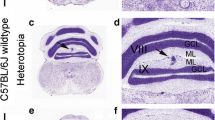Summary
The morphology and development of the many defects in mice of the Little & Bagg X-rayed stock have been reinvestigated, in an attempt to resolve the conflicts in the findings of earlier investigators. The observation that blebs occur on pseudencephalic embryos is incompatible with Bonnevie’s hypothesis that they originate as cerebrospinal fluid in the myelencephalon; other observations support Plagens’ hypothesis that the blebs originate as mesenchymal intercellular fluid. No unitary gene action was found. Four pedigrees of causes were constructed covering, respectively, defects of the central nervous system, bleb-induced lesions and defects of the body wall, morphological defects of the hind limbs, and defects of the urogenital system; there were cross-correlations between defects in the first three pedigrees, but the underlying mechanisms were not identified.
Similar content being viewed by others
References
Bagg, H. J. (1925). Hereditary abnormalities of the viscera. I. A morphological study with special reference to abnormalities of kidneys in the descendants of X-rayed mice.Amer. J. Anat.,36, 275–311.
Bagg, H. J. (1929). Hereditary abnormalities of the limbs, their origin and transmission. II. A morphological study with special reference to the etiology of club-feet, syndactylism, hypodactylism and congenital amputation in the descendants of X-rayed mice.Amer. J. Anat.,43, 167–219.
Bagg, H. J. &Little, C. C. (1924). Hereditary structural defects in the descendants of mice exposed to Roentgen ray irradiation.Amer. J. Anat.,33, 119–45.
Bean, A. M. (1929). A morphological analysis of the foot abnormalities occurring in the descendants of X-rayed mice.Amer. J. Anal.,43, 221–46.
Brown, A. L. (1931). An analysis of the developing metanephros in mouse embryos with abnormal kidneys.Amer. J. Anat.,47, 117–71.
Bonnevie, K. (1934). Embryological analysis of gene manifestation in Little and Bagg’s abnormal mouse tribe.J. exp. Zool.,67, 443–520.
Bonnevie, K. (1936). Pseudencephalie als spontane recessive (?) Mutation bei der Hausmaus. Skr. Norske Vidensk-Akad. Oslo,Math-nat. Kl.,No. 9, pp. 39.
Carter, T. C. (1951). The genetics of luxate mice. I. Morphological abnormalities of heterozygotes and homozygotes.J. Genet.,50, 277–99.
Carter, T. C. (1953). The genetics of luxate mice. III. Horseshoe kidney, hydronephrosis and lumbar reduction.J. Genet.,51, 441–57.
Carter, T. C. (1954). The genetics of luxate mice. IV. Embryology.J. Genet.,52, 1–35.
Carter, T. C. (1956). Genetics of the Little & Bagg X-rayed mouse stock.J. Genet.,54, 311–26.
Chang, T. K. (1939). The development of polydactylism in a special strain ofMus musculus.Peking Nat. Hist. Bull.,14, 119–32.
Deol, M. S. &Truslove, G. M. (1957). Genetical studies on the skeleton of the mouse. XX. Maternal physiology and variation in the skeleton of C57BL mice.J. Genet.,55, 288–312.
Dunn, L. C., Grüneberg, H. &Snell, G. D. (1940). Report of the Committee on Mouse Genetics Nomenclature.J. Hered.,31, 505–6.
Falconer, D. S., Fraser, A. S. &King, J. W. B. (1951). The genetics and development of ‘crinkled’, a new mutant in the house mouse.J. Genet.,50, 324–44.
Gluecksohn-Schoenheimer, S. (1945). The embryonic development of mutants of theSd-strain of mice. Genetics,30, 29–30.
Gorer, P. A., Lyman, S. &Snell, G. D. (1948). Studies on the genetic and antigenic basis of tumor transplantation. Linkages between a histocompatibility gene and ‘fused’ in mice.Proc. Roy. Soc. (B),135, 499–505.
Green, M. C. (1955). Luxoid, a new hereditary leg and foot abnormality in the house mouse.J. Hered.,46, 90–9.
Grobstein, C. (1953). Morphogenic interaction between embryonic mouse tissues separated by a membrane filter. Nature (Lond.),172, 869–71.
Grüneberg, H. (1943a). Congenital hydrocephalus in the mouse, a case of spurious plciotropism.J. Genet.,45, 1–21.
Grüneberg, H. (1943b). The development of some external features in mouse embryos.J. Hered.,34, 88–92.
Grüneberg, H. (1952).The Genetics of the Mouse. The Hague, Martinus Nijhoff; pp. 650 + xiv.
Grüneberg, H. (1955). Genetical studies on the skeleton of the mouse. XVI. Tail-kinks.J. Genet.,53, 536–50.
Grüneberg, H. (1956). Genetical studies on the skeleton of the mouse. XVIII. Three genes for syndactylism.J. Genet.,54, 113–45.
Hamburgh, M. (1952). Malformations in mouse embryos induced by Trypan Blue. Nature (Lond.),169, 27–8.
Ingalls, T. H., Avis, F. R., Curley, F. J. &Temin, H. M. (1953). Genetic determinants of hypoxia-induced congenital anomalies.J. Hered.,44, 185–94.
Kaven, A. (1938). Das Auftreten von Gehirnmissbildungen nach Röntgenbestrahlung von Mauseembryonen.Z. menschl. Vererbgs.-u Konst-lehre,22, 247–57.
Kobozieff, N. &Pomriaskinsky-kobozieff, N. A. (1953). Recherches sur la constitution genotypique des souris luxées et polydactyles.C. R. Soc. Biol.,147, 196–9.
Little, C. C. &Bagg, H. J. (1923). The occurrence of two heritable types of abnormality among the descendants of X-rayed mice.Amer. J. Roentgenol.,10, 975–89.
Little, C. C. &McPheters, B. W. (1932). Further studies on the genetics of abnormalities appearing in the descendants of X-rayed mice.Genetics,17, 647–88.
Murakami, U. (1952). Artificial induction of pseudencephaly, short-tail, taillessness, myelencephalic blebs and some fissure formations (phenocopies) of the mouse.Nagoya, J. med. Sci.,15, 185–94.
Murakami, U., Kameyama, Y. &Kato, T. (1954). Basic processes seen in disturbance of early development of the central nervous system.Nagoya, J. med. Sci.,17, 74–84.
Plagens, G. M. (1933). An embryological study of a special strain of deformed X-rayed mice, with special reference to the etiology and morphogenesis of the abnormalities.J. Morph.,55, 151–83.
Russell, L. B. (1950). X-ray induced developmental abnormalities in the mouse and their use in the analysis of embryological patterns. I. External and gross visceral changes.J. exp. Zool.,114, 545–601.
Slee, J. (1957a). The morphology and development of ‘Ragged’, a mutant affecting the skin and hair of the house mouse. I. Adult morphology.J. Genet.,55, 100–21.
Slee, J. (1957b). The morphology and development of ‘Ragged’, a mutant affecting the skin and hair of the house mouse. II. Genetics, embryology and gross juvenile morphology.J. Genet.,55, 570–584.
Snell, G. D. (1941).Biology of the Laboratory mouse. New York, Dover Publications, Inc.; pp. viii+497.
Waddington, C. H. &Carter, T. C. (1952). Malformations in mouse embryos induced by Trypan Blue. Nature (Lond.),169, 27–8.
Weed, L. H. (1917). The development of the cerebro-spinal spaces in pig and in man.Contr. Embryol. No. 14, Carnegie Inst. Publ.,225, pp. 116.
Woolley, G. W. (1941). ‘Misty’, a new coat color dilution in the mouse,Mus musculus.Amer. Nat.,75, 507–8.
Author information
Authors and Affiliations
Rights and permissions
About this article
Cite this article
Carter, T.C. Embryology of the Little & Bagg. J Genet 56, 401–435 (1959). https://doi.org/10.1007/BF02984794
Issue Date:
DOI: https://doi.org/10.1007/BF02984794




